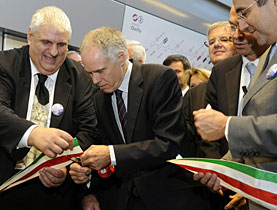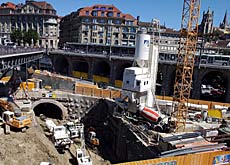Lausanne shows off new metro

Lausanne has inaugurated its new underground railway - the first Swiss metro and the world's first automated driverless system able to cope with the city's slopes.
On September 18 Transport Minister Moritz Leuenberger cut the official red ribbon and tested the six-kilometre north-south line, called the M2.
The new metro cost SFr740 million ($668 million) and is expected to be used by some 25 million passengers a year.
“The M2 is not a object of prestige; it’s a means of transport for the population which will improve their daily quality of life,” said Leuenberger, after travelling by metro to the centre of town. “It’s an integral part of the Swiss transport network and of national importance.”
The new metro has captured local people’s imagination, and Lausanne has gone to town to celebrate the long-awaited inauguration, organising a huge music festival and letting the public try out the M2 over a four-day period.
But the party has been slightly soured by the fact that owing to technical hiccups the new line will only be properly open from October 27.
However, this hasn’t dampened public enthusiasm.
“It’s superb; very quick,” said Micheline Megroz, who lives in Ouchy, at the bottom of the line. “It’s quite expensive but hopefully it might reduce the number of cars in town.”
“It’s great. You feel like you’re in Paris,” said Marc Magnin, testing the high-tech trains with his two young daughters.
Mind the gap
The new line is described as the “spinal column” of the city’s transport system. Trains climb from the crystal-blue lake waters at Ouchy to the woody hills above the city near Epalinges in just 20 minutes, slashing the previous journey time by half.
Building the underground has been a major feat of engineering.
The metro climbs slopes with an average six per cent gradient, with the steepest parts at 12 per cent – a world first. Existing technologies have had to be adapted to cope with Lausanne’s hills, with grooved tracks to help improve adhesion and sophisticated braking systems.
In all, eight new tunnels had to be dug, excavating 350,000 cubic metres of earth “with a spoon”, according to an expert. The tunnelling led to some unwelcome surprises, however.
On February 22, 2005 McDonalds customers at Place Saint-Laurent got a big shock when a ten-metre hole suddenly appeared directly outside the restaurant front door. The tunnelling team had pierced an underground lake which had caused the ground to subside.
Properly adapted?
“The project was a human and technological challenge,” local councillor and head of the M2 project, Olivier Français, told swissinfo. “The metro will improve mobility from the top of the city to the bottom between areas that have strong business activity or are well populated.”
But according to Vincent Kaufmann, an urban mobility specialist at Lausanne’s federal institute of technology, the M2 does not take into account the city’s present development needs.
“The M2 was born out of the need to replace the “Ficelle” [Europe’s first cable funicular railway linking the city centre and the lake] and not from a reflection about the city and its suburbs. Lausanne is growing much more in the south west,” he said.
“Like all cities, Lausanne has grown in attractiveness and so have its activities. More people come here to work, to shop or to have fun. As a result, the city needs to improve its public transport system to reduce individual car traffic. In that respect, Lausanne is still lagging behind other cities in Swiss-German regions,” replied Français.
But the M2 is Lausanne’s way of partly catching up with its Swiss German-speaking neighbours, while encouraging the development of a biotechnology industrial district north of the city where 2,000 jobs will be created in the coming years.
“But it’s true that the city is mainly growing in an east-west direction, in particular towards the west around the federal institute of technology,” admitted Français.
“That’s why I’ve been lobbying for three years to continue to develop the transport system with an M3 and M4,” he said.
Impact
In addition to the hundreds of millions that have been invested in the north-south line, some SFr100 million has also been used to improve the entire existing network. A project for an east-west tramline is also under consideration.
Kaufmann welcomes all these efforts but doubts they will have much of an environmental impact.
“Nothing much will change in terms of car traffic. A much tougher policy should have been introduced for cars and parking in town. However good the public transport offer is, it’s not enough,” said the specialist.
Yet the metro is destined to have a profound impact, Kaufmann told the French-Swiss 24heures newspaper.
“Having a metro means Lausanne now joins the club of big cities,” he said. “From the small capital of a farming canton which denied its urban status, Lausanne has become the first Swiss city with an underground railway.”
swissinfo, Simon Bradley in Lausanne
Length: 6km between Ouchy (373m) and Epalinges (711m).
Journey time from Ouchy to Epalinges: 18 minutes (train every 3 minutes during peak times).
Average gradient: 5.7%; steepest section: 12%.
Maximum speed: 60 km/h.
Capacity: 25 million passengers per year or 6,600 passengers per hour in each direction.
Number of stations: 14.
Number of trains: 15 (each train comprises two compartments).
Train capacity: 220 passengers.
Construction work started: June 17, 2004.
Last tunnel bored: July 28, 2006.
Lausanne’s M1 metro line, which opened in 1991, links the centre of town with Renens and stops at the Federal Institute of Technology in Lausanne.
130 years ago, Lausanne opened “La Ficelle”, Europe’s first cable funicular railway linking the city centre and Ouchy.
The M2 metro project and budget was officially accepted by the Vaud people in a referendum on November 24, 2002 (62%).
Budget: SFr740 million, jointly financed by the Swiss government (12%), canton Vaud (71%) and City of Lausanne (17%).
Planned official opening: October 27, 2008.
There are around 20 automatic metros in the world, including those in Paris, Lyon, Rennes, Lille, Toulouse, London (Docklands Light Railway), New York, Singapore and Nuremberg.

In compliance with the JTI standards
More: SWI swissinfo.ch certified by the Journalism Trust Initiative













You can find an overview of ongoing debates with our journalists here . Please join us!
If you want to start a conversation about a topic raised in this article or want to report factual errors, email us at english@swissinfo.ch.